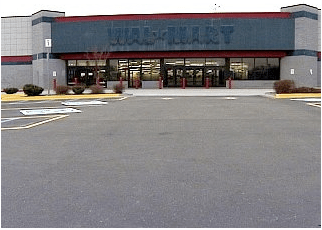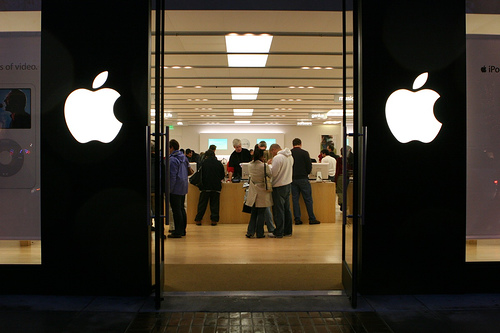The Incredible Shrinking Megastore: Retailers Think Outside the Big Box
3:34 PM EDT on September 15, 2011
They lord over empty parking lots in Hazard, Kentucky; Twinsburg, Ohio; and Lewiston, Washington like the ruins of a lost civilization. Vacant Walmart stores are slowly decomposing in more and more American towns these days. More than 100 of them have been memorialized as part of the group Flickr pool known smugly as "They Sold for Less."

These empty husks -- yet to be filled by any other retail tenant -- are part of the detritus left behind by a paradigm shift in the real estate industry. Signs of the changing times, they tell us what kind of society we were before the bubble burst.
Now, as the commercial real estate industry regroups, evidence is mounting that Walmart and other mega-retailers will take a much different form than they have in the past. The new American shopping experience, according to many industry observers, will be less "suburban big-box" and more "urban destination."
The demise of several mega-retail chains during the recession, including Circuit City and Linens 'n Things, helped produce a vast oversupply of retail space, particularly that of the giant, boxy, just-off-the-interstate variety. Last summer, the research arm of giant commercial real estate firm Colliers International reported that there was nearly 300 million square feet of vacant big box retail space on the market -- 34 percent of total retail vacancy left behind by a recession that walloped commercial real estate almost as hard as housing.
Since 2008 alone, 120 million square feet of big box retail space has become available. To put such numbers in perspective, that is the equivalent of the total shopping center space in Cincinnati, Kansas City and Baltimore combined, Colliers reported.
This period of retrenchment has humbled even the once-mightiest of retail forces. CNN reported last month that Walmart stores suffered their ninth-straight quarterly drop in sales. Another sign of the times: Walmart is no longer enough of a bargain for U.S. consumers, it appears. The mega-retailer has been losing market share to dollar stores.
The situation has apparently reached the point where the retail monolith is rethinking its whole carbon-gulping model. Walmart is joining other retailers in thinking smaller and more urban, says Ed McMahon, a fellow at the Urban Land Institute.
"What the recession has made completely clear is that we have way too much retail," McMahon said. "We are going from the era of the big box to the era of the small box."
Enter the "Walmart Express."
Generally, the opening of a Walmart store isn't the kind of occasion that draws national media attention. Yet, in early June, ABC, Bloomberg News, and USA Today lined up in a parking lot in Gentry, Arkansas. This wasn't a typical Walmart opening. Gentry, Arkansas is home to the first "Walmart Express," a 18,000-square-foot, drug-store-sized prototype of the old, big-box heavyweight.

Walmart plans to open 15 to 20 of the small stores -- about one-tenth the size of a "Supercenter" -- by the end of the year, mostly throughout the southeast but also including three in Chicago. By 2012, they plan to open as many as 350 a year, part of the mega-retailer's strategy to regain its dominance over dollar retailers.
Walmart isn't the only retailer turning its sights on the urban market it once eschewed. Increasingly, retailers see urban areas as the one remaining growth market, said Bob Gibbs, a national site selection and planning consultant with Gibbs Planning in Birmingham, Michigan.
"Retailers used to think that if they went to the edge of suburbia, that farmland would turn into housing," Gibbs said. "They no longer want to do that. They want to be right in the middle of people, even if they’re lower-income than they’re used to."
Industry observers have long marveled that there are approximately 20 square feet of retail space for every U.S. resident, compared to three to four square feet per capita abroad. In urban areas of the U.S., however, the actual ratio is more like one resident to two square feet.
Cynthia Stewart, a researcher with the International Council of Shopping Centers, says the movement toward urban areas is being slowed by a couple of factors. For one, urban site acquisition is traditionally more time consuming and expensive. And financing isn't as easy to secure as it once was. Nevertheless, the market is in urban areas, she said.
"That’s where the opportunities are, for sure," she said.
Another factor shaping the retail landscape has been the growth of online retailers. Again, this trend favors smaller stores in more urban locations, said McMahon.
Where Walmart once reigned supreme, the golden child of the post-recession retail world is Amazon, said McMahon. Fighting traffic, then battling to find a space in an ocean-sized parking lot, is an increasingly difficult sell when online retailers make their products available at the touch of a key.
"If old-school retail outfits like Best Buy want to compete in the bricks-and-mortar world, they'll need to focus on making shopping less hassle and more pleasure, said McMahon. In order to lengthen trips and boost profits, retailers have been adding "cafes," and moving toward Main Street-style, walkable settings. "This is known as the place-making dividend," McMahon said.

Some of the strongest retailers, right now, are those that focus on providing a fun and engaging experience for customers, like Apple retailers or the mall-eschewing Urban Outfitters, the Wall Street Journal reported this spring.
Broad trends signal that the retail industry, like housing, is coming back down to earth. That has the potential to be a good thing. After all, stores like Walmart, Circuit City and Linens 'n Things were always built to the scale of cars, not people. They reinforced and fed off American car-dependency.
Of course, the entry of big-box retailers into urban markets can erode cities too.
Developments like the regrettable Gateway Center in the South Bronx, which impose the suburban-scale big box model on urban areas, only serve to make cities more car-centric.
And a report by the Hunter College Center for Urban Affairs and Planning projected that the entrance of Walmart into New York City would produce a net loss of jobs, by forcing smaller stores out of business. It would also force New Yorkers to pay increased taxes because of Walmart's famously woeful wages and benefits, the report found.
Developments like the Gateway Center, crammed full of parking, also make cities less walkable, the authors wrote. But there isn't a whole lot of room for suburban-style Walmarts to enter New York City in a big way, said Tom Angotti, director of Hunter College's Center for Community Planning. It's not clear yet whether the retailer intends to splash its trademark happy faces all across the New York City market through small stores, he said. And even if it did, it's not clear that the results would be as negative as the big stores.
Furthermore, it's still an open question whether stores like Walmart, which have always made their home in suburban and rural locations, will even work in a different context.
On the other hand, Gibbs said he thinks the increased competition provided by large retailers will ultimately be good for urban consumers, particularly in less-served urban markets like Detroit and Cleveland.
"I think it’s going to make our cities more positive and attractive," he said.
Angie Schmitt is the author of Right of Way: Race, Class and the Silent Epidemic of Pedestrian Deaths in America, and the former editor of Streetsblog USA.
Stay in touch
Sign up for our free newsletter
More from Streetsblog USA
Friday’s Headlines Got Served
Another day, another GOP lawsuit trying to overturn a Biden administration climate change rule.
Disabled People Are Dying in America’s Crosswalks — But We’re Not Counting Them
The data on traffic fatalities and injuries doesn’t account for their needs or even count them. Better data would enable better solutions.
LA: Automated Enforcement Coming Soon to a Bus Lane Near You
Metro is already installing on-bus cameras. Soon comes testing, outreach, then warning tickets. Wilshire/5th/6th and La Brea will be the first bus routes in the bus lane enforcement program.
Talking Headways Podcast: Charging Up Transportation
This week, we talk to the great Gabe Klein, executive director of President Biden's Joint Office of Energy and Transportation (and a former Streetsblog board member), about curbside electrification.
Why Does the Vision Zero Movement Stop At the Edge of the Road?
U.S. car crash deaths are nearly 10 percent higher if you count collisions that happen just outside the right of way. So why don't off-road deaths get more air time among advocates?




